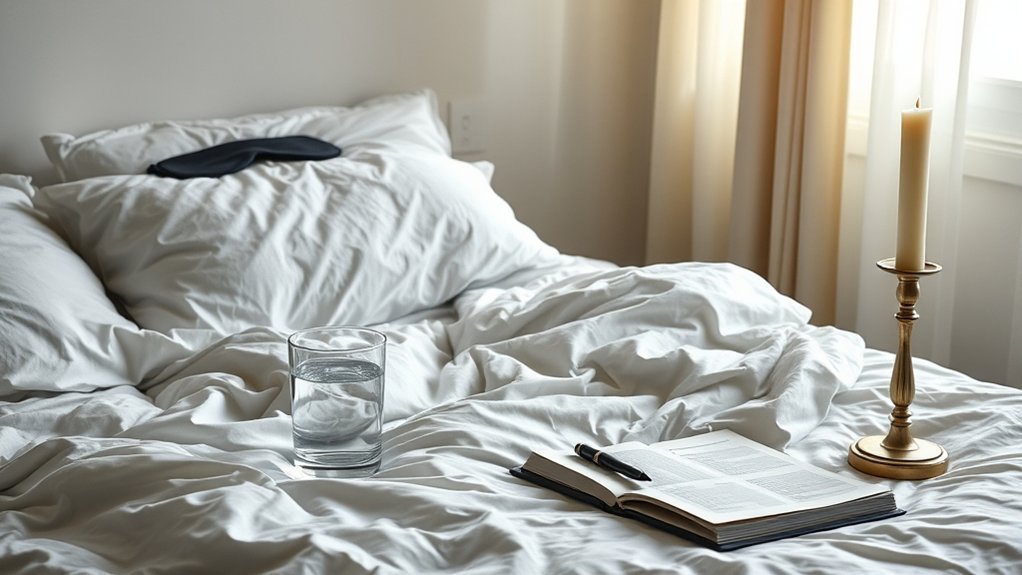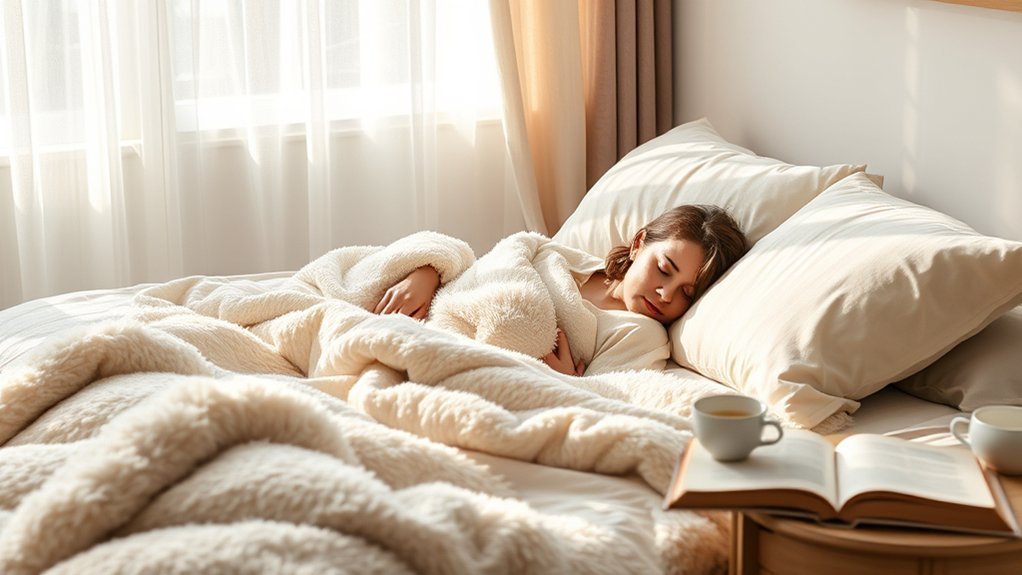When it comes to sleep comfort, recognizing the signs of discomfort is essential for improving your rest. You might find yourself tossing and turning, waking up with aches, or feeling groggy despite hours in bed. These symptoms often point to underlying issues that can greatly impact your sleep quality. Understanding what these signs mean can help you identify solutions. What adjustments can you make to enhance your sleep experience? Let’s explore this further.
Understanding Sleep Comfort

When you think about sleep comfort, it’s essential to recognize that it encompasses not just the mattress and pillows you choose, but also your sleep environment and personal preferences.
The right mattress can support your body in a way that minimizes pressure points, while pillows should align your neck properly. However, factors like room temperature, noise levels, and lighting also play vital roles in your sleep quality.
Choosing the right mattress and pillows is crucial, but don’t overlook the impact of room temperature, noise, and lighting on your sleep quality.
Personal preferences, such as the firmness of your mattress or the type of bedding, greatly influence your comfort. By evaluating these elements, you can create an ideal sleep sanctuary that caters to your unique needs.
Prioritizing these aspects can lead to more restful nights and improved overall well-being.
Common Symptoms of Sleep Discomfort

While you may not realize it at first, sleep discomfort can manifest in various ways that disrupt your rest and overall well-being.
Recognizing these symptoms is essential for addressing the issue effectively. Here are some common signs you might experience:
- Restlessness: You might find it hard to settle down and feel comfortable enough to drift off.
- Frequent Awakenings: Waking up multiple times during the night can indicate discomfort.
- Physical Pain: Issues like back or neck pain can make it tough to find a restful position.
- Daytime Fatigue: If you’re feeling unusually tired or irritable during the day, your sleep quality may be suffering.
Understanding these symptoms can help you take steps toward improving your sleep comfort.
Tossing and Turning: What It Means

Tossing and turning throughout the night often signals underlying discomfort or restlessness that can greatly impact your sleep quality. This behavior might indicate physical issues, such as an uncomfortable mattress or pillow, or it could stem from emotional stress and anxiety.
When you frequently find yourself shifting positions, it’s essential to assess your sleeping environment and habits. Consider factors like room temperature, noise levels, and bedtime routines that may contribute to your restlessness.
Additionally, evaluate your diet and daily stressors, as these can also play significant roles. Recognizing these signs early can lead you to make necessary adjustments, ultimately improving your sleep and overall well-being.
Don’t ignore these signals; they’re your body’s way of communicating its needs.
Waking Up Groggy: Causes and Solutions
Waking up groggy can be frustrating, especially when you need to start your day feeling refreshed and alert.
This common issue often stems from several factors. Here are some potential causes and solutions to take into account:
- Sleep Inertia: Your body might still be in a sleep cycle. Try waking up at the end of a cycle by using a sleep app.
- Sleep Quality: Poor sleep can lead to grogginess. Verify you’re getting enough restful sleep each night.
- Dehydration: Sometimes, grogginess is due to dehydration. Drink water as soon as you wake up to help rehydrate your body.
- Caffeine Dependency: Over-reliance on caffeine can disrupt your natural wakefulness. Think about reducing your intake gradually.
Tackling these factors can help you wake up feeling more alert and energized.
The Role of Your Mattress in Sleep Quality
Feeling groggy in the morning often points to deeper issues with sleep quality, and one significant factor that can greatly impact how rested you feel is your mattress. An uncomfortable or old mattress can lead to tossing and turning, disrupting your sleep cycle. Choosing the right mattress type and firmness can enhance your comfort and support, ultimately improving your sleep quality.
| Mattress Type | Benefits |
|---|---|
| Memory Foam | Conforms to body shape |
| Innerspring | Offers bounce and support |
| Latex | Durable and breathable |
| Hybrid | Combines benefits of foam & springs |
Investing in a suitable mattress not only boosts your comfort but also helps you wake up refreshed and ready to tackle the day.
Pillow Problems: Finding the Right Support
How well do you think your pillow supports your head and neck during sleep?
The right pillow can make a significant difference in your sleep quality, affecting your overall comfort and posture.
A suitable pillow is essential for enhancing sleep quality, ensuring optimal comfort and proper posture.
Here are some essential factors to take into account when selecting your ideal pillow:
- Loft: Choose a height that maintains spinal alignment based on your sleep position.
- Firmness: Opt for a firmness level that balances support and comfort, tailored to your personal preference.
- Material: Reflect on materials like memory foam, latex, or down to find what feels best for you.
- Allergies: If you have allergies, hypoallergenic options can help prevent nighttime discomfort.
Sleep Environment: Creating a Restful Space
While you mightn’t realize it, the sleep environment plays an essential role in determining how well you rest each night. Factors like light, noise, and temperature can greatly impact your ability to fall and stay asleep.
For instance, a dark, quiet room can promote deeper sleep, while excessive light or sound can disrupt it. Consider investing in blackout curtains and white noise machines to enhance your space.
Additionally, keeping your bedroom cool—around 60 to 67 degrees Fahrenheit—helps signal your body that it’s time to sleep. Personal touches, like calming colors and minimal clutter, can also create a soothing atmosphere.
Recognizing Sleep Disorders
When you experience persistent sleep issues, it’s essential to recognize the symptoms that might indicate a sleep disorder.
Common signs like difficulty falling asleep, frequent wakefulness, or excessive daytime fatigue can point to underlying disruptions in your sleep.
Common Sleep Disorder Symptoms
Recognizing the symptoms of common sleep disorders is essential for your overall well-being, as untreated sleep issues can lead to more serious health complications.
By being aware of these symptoms, you can take steps toward better sleep and improved health. Here are some common indicators to watch for:
- Insomnia: Difficulty falling or staying asleep can signal underlying issues.
- Excessive daytime sleepiness: Feeling constantly tired during the day might indicate sleep apnea or other disorders.
- Loud snoring: This can be a sign of obstructive sleep apnea, which needs attention.
- Restless legs: An uncomfortable urge to move your legs can disrupt sleep and indicate restless leg syndrome.
If you identify any of these symptoms, consider seeking professional help.
Identifying Sleep Disruption Causes
Have you ever wondered what might be causing your sleep disruptions? Identifying the root causes can be essential for restoring your sleep comfort.
Start by tracking your sleep patterns and behaviors. Consider factors like stress, caffeine intake, or irregular sleep schedules. Conditions such as insomnia, sleep apnea, or restless leg syndrome could be at play, affecting your ability to fall or stay asleep.
Pay attention to any other symptoms you experience, like excessive daytime sleepiness or snoring. Don’t hesitate to consult a healthcare professional if your sleep issues persist.
They can help pinpoint whether it’s a lifestyle choice or a sleep disorder, guiding you toward effective treatment options tailored to your specific needs.
Tips for Improving Sleep Comfort
To improve your sleep comfort, it’s essential to focus on your environment, routine, and relaxation techniques.
You can create a space that promotes rest, establish a consistent sleep schedule, and incorporate methods to unwind before bed.
These practical steps can greatly enhance your overall sleep quality and comfort.
Optimize Sleep Environment
Creating an ideal sleep environment is crucial for enhancing your overall comfort and quality of rest. A few simple adjustments can make a significant difference in your sleep experience.
Here are some tips to optimize your sleep space:
- Control Light: Use blackout curtains or an eye mask to block out disruptive light that can interfere with your sleep cycle.
- Regulate Temperature: Keep your bedroom cool, ideally between 60-67°F (15-19°C), to promote better sleep.
- Minimize Noise: Use earplugs or a white noise machine to drown out any disruptive sounds that might wake you.
- Choose Comfortable Bedding: Invest in a quality mattress and breathable sheets to guarantee a cozy and supportive sleep surface.
Establish a Sleep Routine
A consistent sleep routine can greatly enhance your comfort and overall sleep quality. By going to bed and waking up at the same time each day, you’ll help regulate your body’s internal clock. This can lead to deeper, more restorative sleep. Here are some practical tips to establish your routine:
| Activity | Time of Day | Duration |
|---|---|---|
| Wind Down | 30-60 minutes before bed | 30-60 minutes |
| Sleep | Same time each night | 7-9 hours |
| Wake Up | Same time each morning | Daily |
| Morning Light Exposure | Upon waking | 15-30 minutes |
Incorporating these habits can make a significant difference in your sleep comfort and overall well-being.
Utilize Relaxation Techniques
While establishing a sleep routine lays a strong foundation for better rest, incorporating relaxation techniques can further enhance your sleep comfort.
These methods help calm your mind and body, making it easier to drift off. Here are four effective techniques to take into account:
- Deep Breathing: Focus on your breath, inhaling deeply through your nose and exhaling slowly through your mouth. This can reduce anxiety and tension.
- Progressive Muscle Relaxation: Tense and then relax each muscle group, starting from your toes and working your way up to your head.
- Meditation: Spend a few minutes in quiet reflection, concentrating on a mantra or your breath to clear your mind.
- Gentle Yoga: Engage in light stretching or restorative poses to release physical tension before bed.
Incorporating these techniques can greatly improve your sleep quality.
Frequently Asked Questions
Can Diet Affect My Sleep Comfort Levels?
Yes, your diet can greatly affect your sleep comfort levels. Consuming heavy meals, caffeine, or alcohol close to bedtime may disrupt your sleep, while balanced nutrition promotes better rest and enhances overall sleep quality.
How Do Stress and Anxiety Impact Sleep Quality?
Stress and anxiety act like shadows, darkening your path to restful sleep. They elevate your heart rate and racing thoughts, preventing your mind from unwinding, ultimately leading to restless nights and fatigue during the day.
What Are the Best Sleep Positions for Comfort?
The best sleep positions for comfort often include sleeping on your side with a pillow between your knees, or on your back with a supportive pillow. Experiment to find what feels best for your unique needs.
How Often Should I Replace My Mattress?
You should replace your mattress every 7 to 10 years. Think of it as revitalizing your bed’s foundation; a worn mattress can lead to discomfort and restless nights, disrupting your precious sleep quality.
Can Exercise Improve My Sleep Comfort?
Yes, exercise can greatly improve your sleep comfort. By increasing physical activity, you help regulate your sleep patterns, reduce stress, and promote deeper rest. Just remember to time your workouts to maximize these benefits effectively.
Conclusion
As you drift into sleep, imagine cocooning yourself in a cloud of comfort, free from the shackles of discomfort. Recognizing the symptoms of poor sleep is your first step toward transformative rest. By fine-tuning your mattress, pillows, and sleep environment, you can cultivate a sanctuary that nurtures your body and mind. Embrace these changes, and let the gentle embrace of restorative sleep wash over you, ensuring you wake up refreshed and ready to greet the day.
